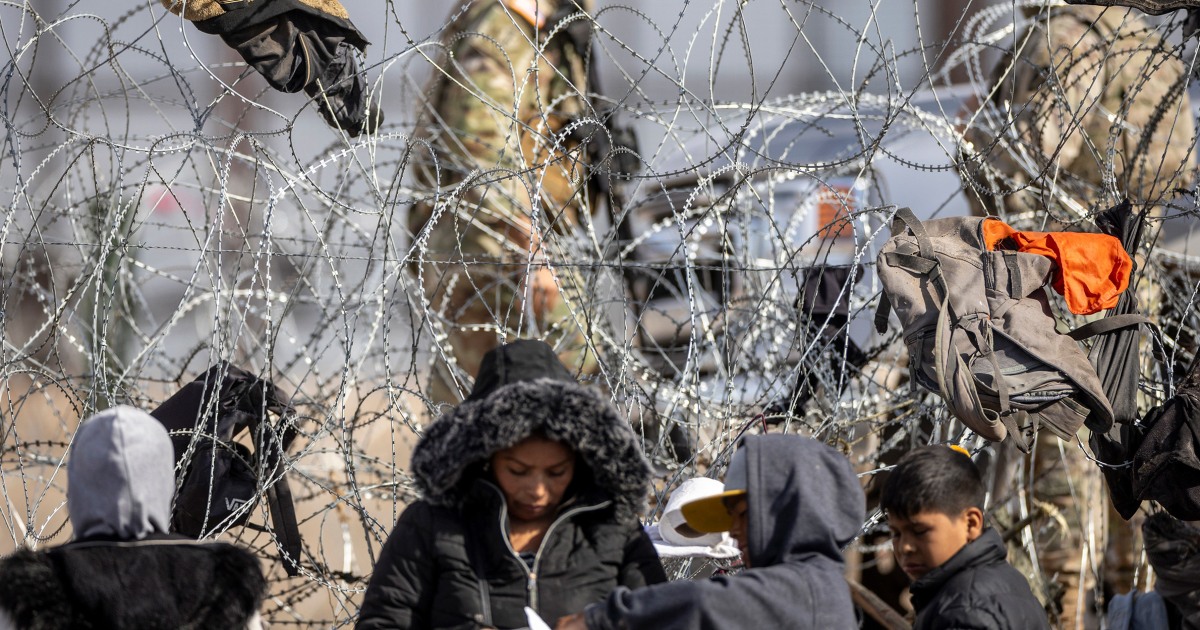By Julie Tsirkin -
NBC News
Former President Donald Trump, House Speaker Mike Johnson and other hardline Republicans have said they oppose a nascent bipartisan immigration deal because it would allow 5,000 migrants to illegally cross the southern border each day.
"It's illegal to cross our border. But apparently, we're cooking up some kind of deal to allow the president to close the border after 5,000 people violate the law," Johnson, R-Louisiana, said Wednesday.
"Why is it 5,000? If we add it up,
it would be a million more illegals in our country every year
before we take corrective action. It's crazy. We shouldn't be wondering what kind of law enforcement tool is put in place when we arrive to 5,000 illegal crossings a day, because that number should be zero," he said, using a term considered offensive to refer to irregular migrants.
Trump made a similar claim to reporters on Tuesday: "That's a terrible bill. 5,000 a day? That's a lot. That's like a record."
But that's not actually what the bipartisan deal would do, according to negotiators who are finalizing details before releasing the full text of the legislation, potentially later this week.
This is what we know:
Immigrants would not simply be released
The new bill would not allow immigrants to cross the border irregularly.
It would end the practice of "catch and release," in which Border Patrol agents release migrants while they await immigration hearings.
Instead, migrants attempting to cross the border illegally
would be detained immediately
and their asylum claim would be decided while they are detained.
If they do not pass the asylum application interview, they would be immediately expelled within 15 days.
What happens to immigrants who try to cross legally with an asylum request?
If the agreement becomes law, immigrants who arrive at the U.S. border through an official port of entry will be diverted to a new "removal authority program" in which they will have 90 days to have their initial asylum application interview.
Those migrants would not be released either: they would be detained or kept under government supervision.
If they fail the initial asylum interview, they would be expelled immediately.
But immigrants who pass the asylum interview will be able to stay in the country for an additional 90 days until their case is resolved.
In the meantime, they would receive a work authorization.
Once their cases are resolved, they could have a path to citizenship.
Where does the figure of 5,000 a day come from?
The bipartisan agreement includes provisions that would allow the border to be closed entirely if a certain number is reached, but these are for border encounters, not crossings.
As already noted, no immigrant attempting to enter the United States illegally will be able to do so unless he passes an asylum interview or is detained and placed under government supervision.
In addition to these provisions, the Department of Homeland Security (DHS) could close the border if too many immigrants with asylum requests appear.
After consulting with Border Patrol and DHS officials, negotiators crafted legislation to give DHS
the authority to close the border
if an average of 4,000 or more border encounters are reached in seven days.
An average of 5,000 or more in seven days would force the border to close.
If the number exceeds 8,500 in a single day, there would also be a mandatory border closure.
What happens if the border is closed?
If the border is closed, up to 1,400 migrants a day trying to enter through official ports of entry would still be eligible to have their asylum claims reviewed.
The rest would be rejected.
Migrants found between ports of entry would be turned away immediately.
If the same person attempts to cross twice when the border is closed between ports of entry, they would be banned from entering the United States for a year.
To reopen the border, crossings would have to be reduced below 75% of the number that caused the border to close for seven days.
DHS would then have
up to two weeks to slowly reopen the border
based on capacity.
The border closure time has a limit to avoid abuses.
By 2024, the limit is 270 days, but the figure is designed to fluctuate from year to year as negotiators expect migrant crossings will decrease with the new law in place.
The measure aims to discourage illegal crossings
Negotiators believe that, over time, this legislation, and the end of the catch-and-release practice, will encourage migrants to legally request asylum at ports of entry, rather than attempting to cross illegally between ports of entry.
The bill will also raise the requirements for seeking asylum.
In addition, it will provide more resources for the border, such as increasing the capacity of detention centers for migrants awaiting asylum applications.

